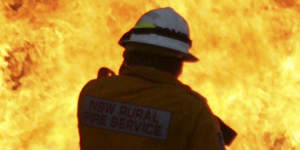But a controversial strategic backburn to defend communities from the Gospers Mountain Fire in late 2019,which subsequently escaped and ran wild over towns in the upper Blue Mountains,was “appropriate in the circumstances”,the coroner found.

RFS firefighters at Bilpin face the bushfire a week after it escaped containment lines.Mick Tsikas
NSW State Coroner Teresa O’Sullivan handed down 28 recommendations from an inquiry into the 2019-20 Black Summer bushfires on Wednesday,following 78 days of hearings held between September 2021 and August last year.
The bushfires raged for 240 consecutive days and destroyed 5.52 million hectares of land – equivalent to 7 per cent of the total land area in NSW – along with an estimated 800 million animals,2476 houses and more than 13,000 head of livestock.
Twenty-five people lost their lives during the season,which was “unprecedented in scale and intensity”.
Five of the recommendations flowed from the coroner’s inquiries into a strategic backburn lit near Mount Wilson in the Blue Mountains on December 14,2109,which was used as a case study into how fires are investigated by the NSW Rural Fire Service and police.
Strategic backburns differ from tactical backburns in that they are usually lit some distance from the bushfire and close to the assets they are designed to protect,rather than close to an impending bushfire to erase the fuel in its path.
The backburn at Mount Wilson was lit to protect towns along the Bells Line of Road from the Gospers Mountain Fire,but escaped within hours of ignition. It later spotted into the Grose Valley,where it came under the jurisdiction of another local government area and was renamed the Grose Valley Fire.
The inquiry heard that the backburn introduced fire to the upper Blue Mountains towns of Bilpin,Berambing and Mt Tomah days before it might otherwise have arrived,but the RFS elected not to conduct a cause and origin investigation.
When the police officer in charge of investigating the Grose Valley Fire asked her forensic team to visit the site where the fire began,RFS staff directed the officers to the place that the backburn had spotted into the Grose Valley,and the site of ignition was never examined.
The RFS described the Grose Valley Fire in an internal report as a continuation of the Gospers Mountain Fire.
O’Sullivan found that this characterisation was misleading:“The Fire Investigation Report ought to have reflected what actually occurred at the scene;that is the Grose Valley Fire occurred as the unintended consequence of a strategic backburn lit in response to the Gospers Mountain Fire.”
The evidence was silent as to why the RFS did not conduct its own cause and origin investigation,she said. “To theorise why would result in impermissible speculation and conjecture.”
O’Sullivan recommended to the NSW Rural Fire Service Commissioner and NSW Police Commissioner that:
But O’Sullivan accepted the evidence of the court-appointed expert that the backburn was appropriate in the circumstances,notwithstanding that the strategy had resulted in other backburn escapes earlier in the season.
Mountain Lagoon resident Kooryn Sheaves,who was caught beneath the escaped backburn at Berambing,said the language was weak and none of the recommendations would prevent a repeat event.
“There’s nothing compelling either of the government institutions,the RFS or the NSW Parks and Wildlife Service,to do anything differently and that’s why we will end up with more of the same,” Sheaves said.
She had hoped the coroner would recommend the appointment of an Inspector-General of Emergency Services,similar to the Victorian and Queensland models,whose mission was to investigate and report back quickly,so communities could move on.
Ten of the coroner’s 28 recommendations related to decisions about aircraft safety and when to deploy Very Large Air Tankers.
American firefighters Ian McBeth,44,Paul Hudson,42,and Rick DeMorgan,43,died when their Large Air Tanker[LAT] crashed after dropping fire retardant on the Good Good Fire near Cooma on January 23,2020.
An Australian Transport Safety Bureau report tendered at the hearing criticised the NSW Rural Fire Service for sending the aircraft to the area without aerial supervision and for not providing the pilot with sufficient information to make an informed decision.
The inquiry heard that other aircraft including a supervising plane known as a birddog had rejected the task to fly due to the dangerous conditions,but this had not been relayed to the crew of the LAT.
The coroner recommended that when one crew has rejected a task,that information is relayed to other aircraft likely to be tasked.
It should also ensure pilots were provided with a weather forecast,reports from the local area,any known hazards,a summary of assets and contact details for crew at the fireground.